Magical And Malicious Creatures That Prey Upon Yggdrasil In Norse Beliefs
A. Sutherland - AncientPages.com - There are many shrines in Asgard and Midgard, but most sacred of all is Yggdrasil, the largest of all trees. The branches spread all over the world and reach the sky.
The tree grows thanks to three deep roots. One of the roots goes under Asgard, the other under Jotunheim, where the empty swallow, Ginungagap - primordial void - once existed in the old days.
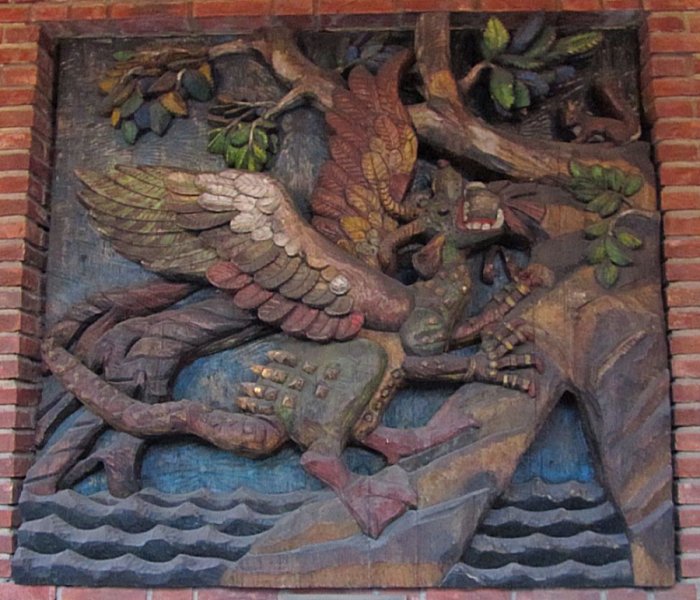 Nidhogg (and other creatures) is gnawing at the root of the sacred tree Yggdrasil. Photo credit: Eir Torvik / Rådhusets forvaltningstjeneste (City Hall General Services)
Nidhogg (and other creatures) is gnawing at the root of the sacred tree Yggdrasil. Photo credit: Eir Torvik / Rådhusets forvaltningstjeneste (City Hall General Services)
Ginungagap separated Nifelheim, the fog world from the southern part of Muspelheim, the land of primordial fire and flames.
The third root extends over the realm of death in Niflheim, the most inhospitable and darkest world of the densest mists and fogs. It was the first of the nine worlds created within Yggdrasil and located to the north of the great plain of Ginnungagap.
Under these roots, there is a place for a fearsome well, Hvergelmer (in Old Norse "bubbling boiling spring"), attested in Snorri Sturluson’s Poetic Edda. In Norse mythology, Hvergelmer is a spring that runs past the northern root of the sacred Yggdrasil and then divides into eleven ice-cold rivers. From there it’s very close to the frost giants that threatened the world with eternal winter.
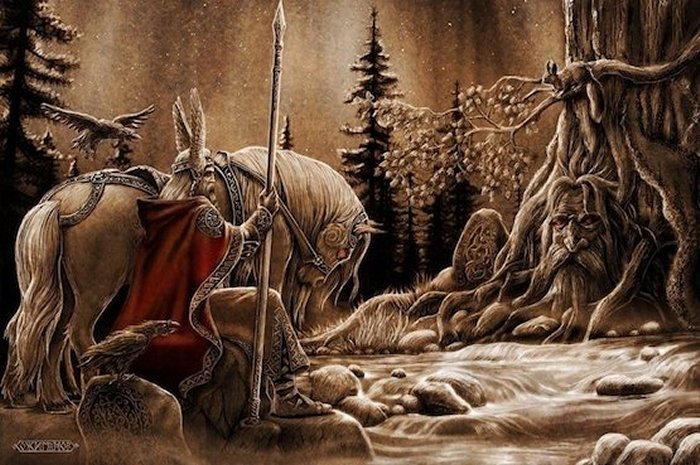 Many visitors come and ask for a drink but at first, they have to provide a sacrifice of some kind.
Many visitors come and ask for a drink but at first, they have to provide a sacrifice of some kind.
In Jotunheim, the giant Mimir (“The Wise One") has the well filled with knowledge, wisdom, and understanding in the world. Mimir owns the well and drinks its water. Both the well and Mimir’s abode are located beneath the second root of Yggdrasil, the World Tree. Mimir guards the well, drinks from it on a daily basis and gains his wisdom from this source. He also feeds Yggdrasil daily on the waters from his well.
Below the third root that reaches the Asgard (Asgård) lies the very sacred Well of Urd. At this well, where the branches of Yggdrasil drip honeydew, the gods gather every day to hold their assembly, to discuss urgent problems and to settle disputes.
Urd (Fate), Verdandi (Being), and Skuld (Necessity), who are the three most important among the Norns, the goddesses of destiny, also live beneath the Yggdrasil and beside the Urd’s Well. Every day the three Norns water the tree with pure water and whiten it with clay from the spring, so Yggdrasil can survive and flourish.
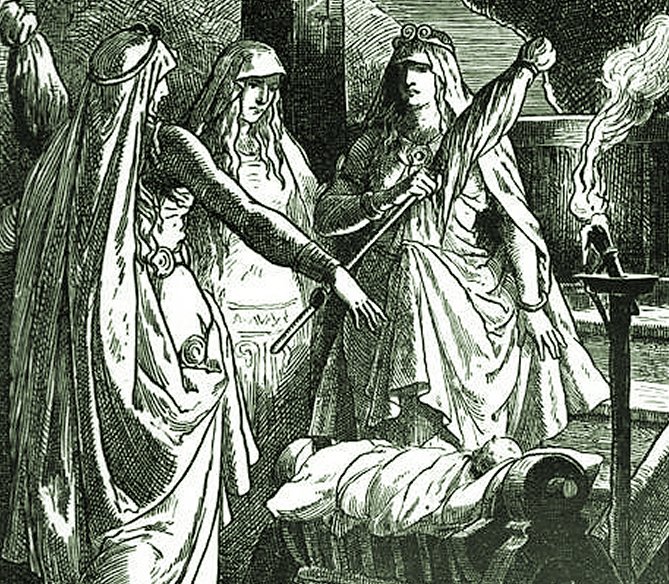 The Norns (1889) by Johannes Gehrts. Public Domain
The Norns (1889) by Johannes Gehrts. Public Domain
The Norns rule the fate of all men and even of the Aesir gods themselves. They direct the unchallengeable laws of the universe as well. When a child is born, the goddesses of destiny determine the child’s fate.
A certain runic inscription, carved on a piece of wood and discovered in the historic Borgund Stave Church in Borgund in Western Norway, says:
“The Norns determine good and bad things and they have brought great sorrow to me.” The inscription was also interpreted as follows:
“The Norns have done both good and evil.”
Urd, Verdandi, and Skuld are very powerful beings that decide the good and evil of life, but they are not the only ones. There are many others and their rules must be followed because no one lives one day longer than the Norns grant him or her.
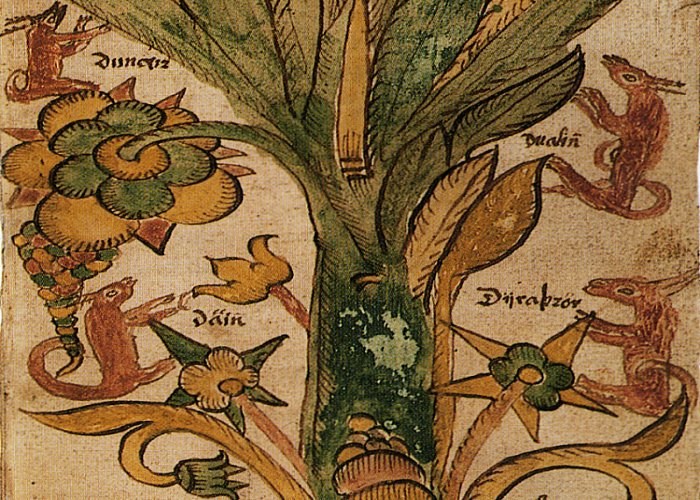 This drawing made by a 17th-century Icelander shows the four stags on the World Tree. Neither deer nor ash trees are native to Iceland. Public Domain
This drawing made by a 17th-century Icelander shows the four stags on the World Tree. Neither deer nor ash trees are native to Iceland. Public Domain
The fascinating world of the sacred Yggdrasil has many animals that dwell among its branches such as a wise eagle, Hræsvelgr (Räsvelg) known as "Corpse Swallower", in Old Norse), a hawk, four stags, Nidhogg, a terrible snake, and the little Ratatoskr. They are evil residents of Yggdrasil that wish to destroy the sacred tree. Four deer run around the branches of the ashes and bite off the young shoots. The snake Nidhogg (Nidhögg), a corpse-eating dragon lives entwined around Yggdrasil’s foot and is busy with stalking in the roots of Yggdrasil.
See also:
Skadi: Goddess Of Destruction, Giantess And Patron Of Winter Hunters And Skiers In Norse Mythology
Death Of Kvasir And How Famous Mead Of Poetry Was Created, Stolen And Finally Recovered By Odin
War Between The Aesir And The Vanir Gods In Norse Mythology
His plan is to kill the tree because he knows that its death would be signal the end of the gods.
At the topmost of the World Tree, an eagle is sitting in the topmost branches, flapping its wings and creating the winds in Midgard, the realm of humans. A hawk Vedfolnir (Vedrfolner), attested in Snorri’s Poetic Edda and Prose Edda, is the one who is pale by wind and weather; he sits on the eagle’s forehead between his eyes.
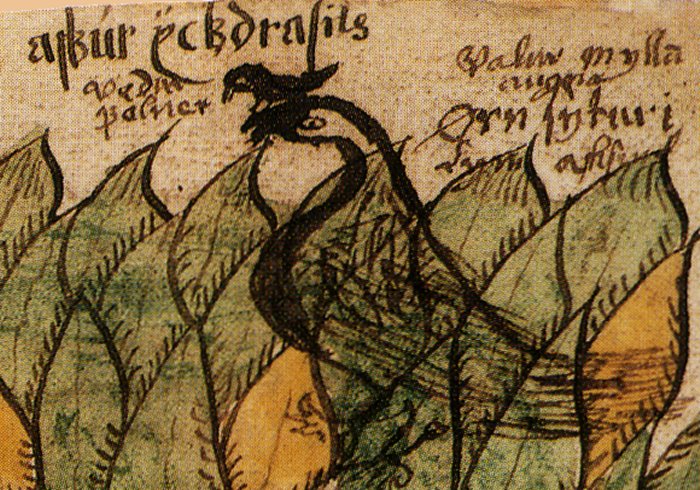 A 17th-century Icelandic manuscript shows a hawk, Veðrfölnir, on top of an eagle on top of a tree, Yggdrasil. Public Domain
A 17th-century Icelandic manuscript shows a hawk, Veðrfölnir, on top of an eagle on top of a tree, Yggdrasil. Public Domain
Ratatoskr, also an important inhabitant of Yggdrasil, spreads gossips and carries insults between Nidhogg and an eagle, a giant who takes the form of an eagle.
Other enemies of Yggdrasil involve Dain, a fully grown male deer, or stag, that lives among the branches of Yggdrasil, and eats its leaves. The other three stags are Duneyr, Durathror, and Dvalin, which also gnaw Yggdrasil’s leaves and branches. Not any of them is a friend of the tree.
See also: More Myths And Legends
The four stags are mentioned in the story of Yggdrasil told in Griminismal, part of the Poetic Edda, and retold by Snorri in Gylfaginning.
Despite many enemies, evergreen Yggdrasil stands over the Well of Urd, the Honeydew that falls from its leaves gives nourishment to the bees. The tree has a vitality which makes it stand tall and strong at all times.
Written by – A. Sutherland - AncientPages.com Senior Staff Writer
Copyright © AncientPages.com All rights reserved. This material may not be published, broadcast, rewritten or redistributed in whole or part without the express written permission of AncientPages.com
Expand for referencesReferences:
Viking, Tidskrift for Norroen Arkeologi
Lindow, J. Norse Mythology
Davidson, H. E. Gods and Myths of Northern Europe
More From Ancient Pages
-
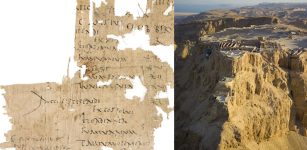 Rare Ancient Paycheck Of A Roman Legionary Soldier Found At Masada
Archaeology | Feb 16, 2023
Rare Ancient Paycheck Of A Roman Legionary Soldier Found At Masada
Archaeology | Feb 16, 2023 -
 Discovery Of Chromosomes Offers Evidence Of Ancient Humans Living In South America Over 18,000 Years Ago
Archaeology | Aug 21, 2022
Discovery Of Chromosomes Offers Evidence Of Ancient Humans Living In South America Over 18,000 Years Ago
Archaeology | Aug 21, 2022 -
 Three Roman Shipwrecks Discovered Off Tunisian Coast – One Is 2,000-Year-Old
Archaeology | Jun 9, 2023
Three Roman Shipwrecks Discovered Off Tunisian Coast – One Is 2,000-Year-Old
Archaeology | Jun 9, 2023 -
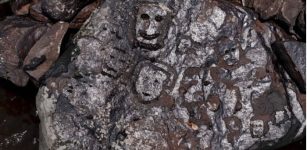 Drought Reveals 2,000-Year-Old Rock Carvings In Brazil’s Amazon
Archaeology | Oct 23, 2023
Drought Reveals 2,000-Year-Old Rock Carvings In Brazil’s Amazon
Archaeology | Oct 23, 2023 -
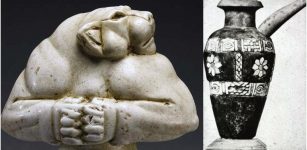 Mesopotamian City Jemdet Nasr Dated To 3100–2900 BC: Sophisticated Irrigation Techniques And Earliest Cylinder Seals
Featured Stories | Dec 18, 2016
Mesopotamian City Jemdet Nasr Dated To 3100–2900 BC: Sophisticated Irrigation Techniques And Earliest Cylinder Seals
Featured Stories | Dec 18, 2016 -
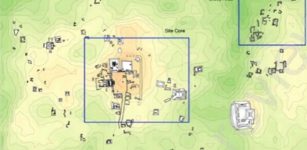 What Can Ancient Toilets Teach Us About Maya Life And Tamales?
Archaeology | Jun 9, 2022
What Can Ancient Toilets Teach Us About Maya Life And Tamales?
Archaeology | Jun 9, 2022 -
 Neolithic Monuments, Prehistoric Pits And Anglo-Saxon Cemetery Unearthed In England
Archaeology | Apr 19, 2016
Neolithic Monuments, Prehistoric Pits And Anglo-Saxon Cemetery Unearthed In England
Archaeology | Apr 19, 2016 -
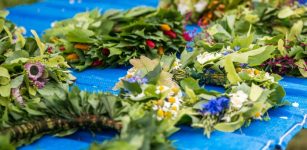 Summer Solstice Festivals Around The World – Midsummer Celebration Is An Ancient Tradition Still Alive
Ancient Traditions And Customs | Jun 24, 2021
Summer Solstice Festivals Around The World – Midsummer Celebration Is An Ancient Tradition Still Alive
Ancient Traditions And Customs | Jun 24, 2021 -
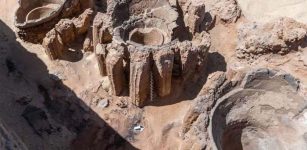 World’s Oldest Beer Factory Discovered In Abydos, Egypt
Archaeology | Feb 16, 2021
World’s Oldest Beer Factory Discovered In Abydos, Egypt
Archaeology | Feb 16, 2021 -
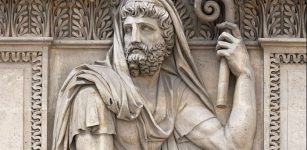 Numa Pompilius – Remarkable Legendary Second King Of Ancient Rome Who Succeeded Romulus – Did He Ever Exist?
Featured Stories | Mar 2, 2018
Numa Pompilius – Remarkable Legendary Second King Of Ancient Rome Who Succeeded Romulus – Did He Ever Exist?
Featured Stories | Mar 2, 2018 -
 Unusual Find – Headless Skeletons Discovered In A 7000-Year-Old Mass Grave In Slovakia
Archaeology | Jan 12, 2023
Unusual Find – Headless Skeletons Discovered In A 7000-Year-Old Mass Grave In Slovakia
Archaeology | Jan 12, 2023 -
 Mysterious Ancient Village In A Prehistoric Anomalous Zone – Unexplained Sightings And Sounds – Part 1
Featured Stories | Jul 27, 2020
Mysterious Ancient Village In A Prehistoric Anomalous Zone – Unexplained Sightings And Sounds – Part 1
Featured Stories | Jul 27, 2020 -
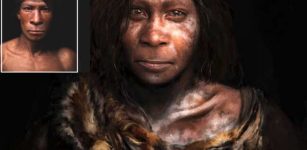 New Details On Neanderthals – Revealed By Museum Exhibition In Norway
Archaeology | Jun 16, 2023
New Details On Neanderthals – Revealed By Museum Exhibition In Norway
Archaeology | Jun 16, 2023 -
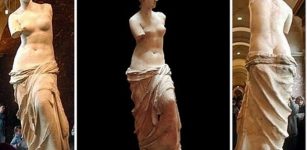 On This Day In History: Statue Of Venus de Milo Is Discovered On The Aegean Island Of Milos – On Apr 8, 1820
News | Apr 8, 2016
On This Day In History: Statue Of Venus de Milo Is Discovered On The Aegean Island Of Milos – On Apr 8, 1820
News | Apr 8, 2016 -
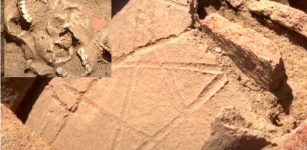 Early Christian Necropolis Unearthed In Sant’Appianu Cathedral In Sagone, Corsica
Archaeology | Aug 3, 2020
Early Christian Necropolis Unearthed In Sant’Appianu Cathedral In Sagone, Corsica
Archaeology | Aug 3, 2020 -
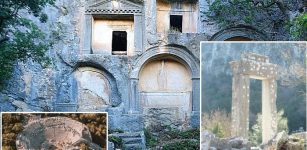 Termessos – Where History And Mythology Marked People’s Daily Lives
Featured Stories | Mar 16, 2024
Termessos – Where History And Mythology Marked People’s Daily Lives
Featured Stories | Mar 16, 2024 -
 Herculaneum Time Capsule: Ancient Scrolls With Secrets Buried Under Volcanic Ash And Stones
Civilizations | Aug 24, 2016
Herculaneum Time Capsule: Ancient Scrolls With Secrets Buried Under Volcanic Ash And Stones
Civilizations | Aug 24, 2016 -
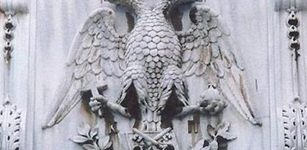 Mystery Of The Ancient Double-Headed Eagle Symbol
Ancient Symbols | Oct 11, 2017
Mystery Of The Ancient Double-Headed Eagle Symbol
Ancient Symbols | Oct 11, 2017 -
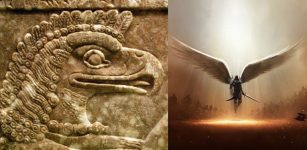 Apkallu – Seven Antediluvian Sages Created By God Enki – Were They The Watchers?
Featured Stories | Mar 27, 2019
Apkallu – Seven Antediluvian Sages Created By God Enki – Were They The Watchers?
Featured Stories | Mar 27, 2019 -
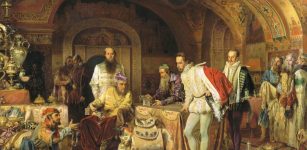 Ivan The Terrible: Military Arsenal Unearthed Near Moscow
Archaeology | Jan 2, 2016
Ivan The Terrible: Military Arsenal Unearthed Near Moscow
Archaeology | Jan 2, 2016
